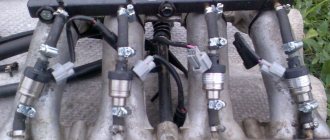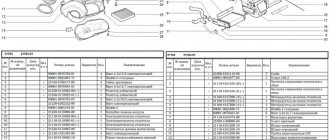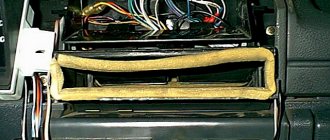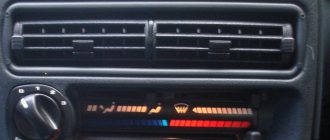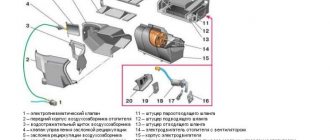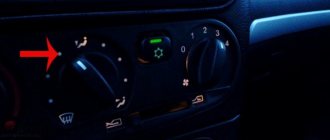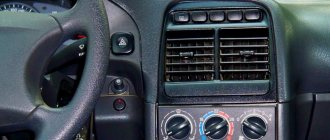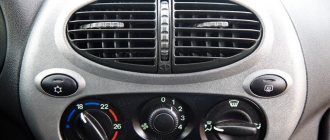It is indispensable if you live outside the city, it justifies itself as a car for the whole family and is very stable. With the arrival of the autumn-winter period, good and high-quality operation of the heater will be relevant. If the stove does not heat well, the Chevrolet Niva will become a very uncomfortable car, and you will have to forget about its advantages. Moreover, if the car was parked in the garage overnight, it is problematic to be in it and feel the cold comparable to that of a basement. Let's consider the main components of this technological unit of the car:
- radiator;
- fan;
- dampers;
- pipes;
- air duct;
- unit for regulating fluid movement.
The stove will work properly if each of its parts works properly and in a coordinated manner.
Main malfunctions and methods for eliminating them in the Chevrolet Niva car stove:
- The ventilating elements of the heater burned out. This will be immediately visible in winter by the formation of characteristic condensation on the windows. They simply need to be replaced with new ones;
- the unit that regulates the temperature breaks, since it can be made of plastic rather than rubber or rubber, which has greater wear resistance. Naturally, the possibility of the cable falling off should also be considered. Depending on the situation, you either carefully return the part to its place and it continues to perform its traction function, or you need to purchase a new one and replace it;
- poor filter performance due to clogging. Accordingly, they need to be cleaned or purged, otherwise air pockets will form in the stove, disrupting its productive operation;
- problems with the cooling system - you should rinse and fill in a new coolant - antifreeze or antifreeze, which is changed annually for prevention;
- The damper that regulates the supply of cold and hot air has broken. It will have to be replaced;
- The thermostat is not working well. It might simply get jammed. Please note that the heater will malfunction when driving fast. It must be replaced immediately, because poor quality work will lead to an increase in temperature throughout the Chevrolet Niva;
- The resistor on the radiator has burned out or the radiator is clogged. There can be many reasons: antifreeze, insects, leaves and other debris. Also, water should not be allowed to get into this part of the stove. The radiator must be cleaned periodically, and in case of a malfunction, a new resistor must be purchased and installed. Cleaning is carried out with compressed air or a vacuum cleaner, an industrial hair dryer;
- The heater control unit, the so-called controller responsible for regulating the interior temperature, may fail. This is already a problem with electronics; to fix it, you need the services of a specialist.
Recommendations for normal and long-term operation of the heating-cooling system in a Chevrolet Niva:
- periodically lubricate the bearings of the stove ventilation device;
- Check the filters and radiator regularly, and if necessary, clean them or purchase new ones. The filter cleans the air from dust and infections coming from the street;
- remove air pockets when the engine is idling and muffled;
- clean the pipes with citric acid or a special product, since poor quality coolant forms sediment and build-up in the pipes.
At a temperature of minus 20 degrees, the Chevrolet heating system should heat the top of the cabin to an average of 10 degrees, and the temperature in the legs is 5-7 degrees higher. Passengers in the rear seats will receive air with a temperature of about 14 degrees. This way, everyone will be in comfortable conditions, and the trip in winter will be quite pleasant.
To avoid problems with the heating and ventilation system, preventive maintenance should be carried out systematically. After all, a car is a complex device that will drive well and function properly only with proper care.
Of course, problems with the stove are not the most critical troubles or breakdowns, but your health, mood and, naturally, performance depend on your comfort and the comfort of your passengers. We value not the quantity, but the quality of the years lived, so let your Chevrolet Niva be a high-quality, elegant and capable car.
How to fix the problem in which the stove on a Chevrolet Niva does not blow at your feet
It is not difficult to fall in love with a vehicle like the Chevrolet Niva with all your heart. The car is truly beautiful and comes with a fair amount of benefits. Unfortunately, in modern reality it is almost impossible to find a device or mechanism that does not have flaws.
The Chevrolet Niva was also no exception, so it is not at all surprising that after some period of direct operation of this vehicle, complaints from car owners begin to arrive. This flow of some discontent especially intensifies in the winter.
Complaints are related to the fact that on the Chevrolet Niva the stove does not blow into the feet at all, which freeze very quickly, depriving both the driver and passengers of comfort. Why the stove refuses to blow in this direction is not a mystery. It’s just that most drivers are convinced that this is a technical defect due to insufficient attention from the designers who developed such a model.
To ensure proper comfort for the driver and passengers, it will be necessary to modify the heater damper drive.
This way you can come to an agreement with the Niva Chevrolet stove and make it evenly warm up the interior.
The stove is good (if it works). The stove is hot, the cabin is warm, I can’t find where to blow into my feet...
The filter cleans the air from dust and infections coming from the street; remove air pockets when the engine is idling and muffled; clean the pipes with citric acid or a special product, since poor quality coolant forms sediment and build-up in the pipes. As a result, it cannot effectively blow in several directions at once, but when the flow is directed towards the legs, the air is distributed anywhere, but not in the desired direction. This is done as follows:
If you move the lever in the opposite left direction until it stops, air will flow between the side and top deflectors. Actually, this is a design feature of this model.
Unfortunately, in modern reality it is almost impossible to find a device or mechanism that does not have flaws. The Chevrolet Niva was also no exception, so it is not at all surprising that after some period of direct operation of this vehicle, complaints from car owners begin to arrive. This flow of some discontent especially intensifies in the winter.
Complaints are related to the fact that on the Chevrolet Niva the heater does not blow into the feet at all, which freeze very quickly, depriving both the driver and passengers of comfort.
Why the stove refuses to blow in this direction is not a mystery. It’s just that most drivers are convinced that this is a technical defect due to insufficient attention from the designers who developed such a model.
The radiator must be cleaned periodically, and in case of a malfunction, a new resistor must be purchased and installed. Cleaning is carried out with compressed air or a vacuum cleaner, an industrial hair dryer; The heater control unit, the so-called controller responsible for regulating the interior temperature, may fail.
We recommend: Why antifreeze boils in the expansion tank: a review of common breakdowns
This is already a problem with electronics; to fix it, you need the services of a specialist. Recommendations for normal and long-term operation of the heating-cooling system in a Chevrolet Niva: The filter cleans the air of dust and infections coming from the street; remove air pockets when the engine is idling and muffled; clean the pipes with citric acid or a special product, since poor quality coolant forms sediment and build-up in the pipes.
At a temperature of minus 20 degrees, the Chevrolet heating system should heat the top of the cabin to an average of 10 degrees, and the temperature in the legs is degrees higher.
You can also relatively smoothly regulate the amount of air supplied in different directions. After such a modification, you may encounter a decrease in air flow. This is due to air redistribution.
Chevrolet Niva 2004, 80 l. With. — self-repair
The result is that in the middle position the cabin is still quite cool. To eliminate this drawback, you will need an unnecessary plastic canister.
We cut off the neck from it and attach it to the deflector. The result is a fairly powerful and targeted flow.
The cause of cold in the cabin may also be a simple heater failure. Therefore, we will consider the most common causes of breakdowns. All of them lie on the surface, and in principle are characteristic of many modern cars. The most common cause is a blown fuse. Check the appropriate fuse and replace it if necessary.
The main reasons when the stove does not blow warm air into your feet
The heater radiator is leaking
Before gutting the air ducts and air dampers, you need to make sure that the antifreeze warms up to its operating temperature.
And this may depend on a lot of factors - the quality of the pump , the tightness of the system and the heater radiator , including the correct operation of the thermostat, and the quality of the coolant. If the temperature with a fully warmed-up engine is within 80-90 degrees, we look for the reasons for the lack of air in the legs in the design of the heater.
Turn on maximum heat.
A feature of the stove on a Chevrolet Niva is the absence of a heater radiator tap, that is, antifreeze circulates in a full circle in winter and summer and passes through the heater radiator. Taking this fact into account, the factory somewhat complicated the design of the air ducts and air dampers - there are two of them in the Chevrolet Niva.
Upper deflector flap.
One works for frontal airflow, the second is responsible for supplying air to the feet of the front and rear passengers and the driver. It is with this damper that problems arise that we will try to solve.
Correctly turn on the foot airflow
It turns out that even after several years of owning a Niva Chevrolet, not everyone knows how to properly turn on the warm air to blow their feet. By using fan speed controls and damper position controls, and using sound logic, we can end up with a situation where the entire flow of hot air is directed onto the windshield and into the face of the driver and front passenger. Of course, the car is warm, even hot, but your feet are cold.
Practice has shown that Shniva has a special algorithm for supplying hot air to the legs . On most instances this is done like this:
- We warm up the engine until the flow of warm air is clearly felt by the hand.
- The fan speed switch is set to the fourth position, 4th speed.
- Turn the airflow direction knob to exactly 12 o'clock.
- Immediately return it to the 10-11 o'clock position.
Correct position of the stove blower control.
- The air damper will make a characteristic click and the air flow will flow to your feet. Now you can set the blowing intensity at your discretion.
- If this method did not work the first time, the second or third time it works in 90% of cases.
Having remembered this sequence, you will have to turn on the airflow several times, after which the damper will rub in and find the desired position itself in accordance with the pictogram on the adjustment handle.
It's all about the inaccuracy of assembling the heater assembly - backlashes and gaps interfere with air distribution and setting the damper in the desired position from the first turn on.
Design
Why doesn't the heater blow into your feet on a Chevrolet Niva? To answer this question, you should first consider the design of the heater on this model. Heating here is connected with the ventilation of the car. External air passes through the radiator, heating up, after which the flow enters the cabin. There are 3 ways for this:
- When the lever is in the extreme right position, the feed is carried out through the upper deflectors. In this case, the windshield is blown;
- In the extreme left position, the flows are distributed between the top and side deflectors. This is the most useless position. Almost no warm air is supplied to the windshield, and through the side deflectors it goes more under the dashboard;
- In the middle position it should blow into your feet, but in practice you get the feeling that the heater fan is idling and does not affect the temperature in the cabin.
Actually, these features of the Chevrolet Niva stove make drivers want to modify it. Otherwise, the heater shows quite acceptable performance.
Chevrolet Club - Information
First of all, check the flow in the expansion tank at idle. There should be a vigorous flow. If there is no stream, then throw the pump in the trash. The pump must be original, no cheap one will do, it has a smaller impeller. With a non-original or faulty pump, a stream appears in the tank only when you re-gas it.
Pump and test. Lech wrote:. Good day everyone! I would also like to make my small contribution to the forum if, of course, anyone else is interested. Not long ago I had problems with the heater which I solved by replacing the pump. If I posted the topic incorrectly, please correct me.
The essence of my problem was that with the engine well warmed up, the temperature in the cabin left much to be desired. The strong air flow from the heater was lukewarm. Thanks to the respected forum participants, the decision was made to change the pump. Indeed, in my case, the stream in the reservoir at idle was completely absent, appearing only closer to the engine speed. Having removed the pump, it turned out that there was a “hepa” with a small impeller:. The hepa impeller has a diameter of 64mm. The TZA impeller has a diameter of 72mm.
Measuring the air temperature from the heater in the glass mode with a well-warmed engine before replacing the pump showed the following result: After replacing the pump with the original one, a steady stream appeared in the expansion tank at idle speed and the heater air temperature in the same mode on the glass increased significantly: Now I I felt warm, I even unscrew the heat-cold knob to 12 hours, otherwise it’s too hot..
The presence of a wheel on the windshield is especially incomprehensible. What can we now understand from this diagram? Theoretically, nothing blows from there until you put the front in position.
In practice, it constantly blows from the front if the dampers are not treated using the technology below. In short, you need to turn the wheel in the front position. Feel what is blowing from there and never touch it again. Additional airflow to the windshield never hurts. The diagram has errors, but not major ones, the main thing is to grasp the meaning. Treatment using technology improves the overall warming of the feet.
Indications for treatment are:. This bonus significantly increases the comfort in the car interior when the damper is in frosty weather.. Bigfoot wrote a:. Everything works perfectly, now it blows where I want, in the legs of Tashkent it even blows in the legs of the rear passengers. This has never happened before.. It is better to increase the efficiency of heating the legs by eliminating air leaks from the large technological holes podiums for fastening the damper cables, which are installed at the factory no one is fooling around.
The holes are through, air is blown out of them from the stove... Here they are visible in the light. Don’t put the foam rubber too far into them, otherwise the damper will jam the heat and cold. In the photo the largest one is in the center. The flap with its small squiggle on the right can pinch and drag pieces of foam rubber inside. Where else can cold air siphon from?
From the joints of part number 4. Owners of Shniv with a condo can relax or tense up. Because simply removing the glove compartment will not solve anything. But you can check it by removing the glove compartment and rushing through in the cold with a breeze, the passenger can feel everything.. No problems were found with the other joints. Maybe this will reassure owners of Eltse trim levels.
Main stove malfunctions
Stove malfunctions can be very different. The most common reason for its failure is:
- heater valve malfunction;
- damage to radiator pipes;
- failure of the additional resistor;
- radiator damage;
- control unit problems.
We recommend: Step-by-step replacement of the VAZ-2112 pump 16 valves
As a result of any of the above situations, the stove stops working normally.
Warm air does not enter the lower part of the cabin
Before repairing the stove, you should check the temperature of the coolant (coolant). Perhaps the problem is not in the interior heater, but in the cooling system. If the engine warms up to operating temperature (90˚C), then the cause of the malfunction should be sought in the stove.
With the help of damper position regulators, warm air is directed to different parts of the cabin
The dampers should be adjusted first. To supply hot air to your feet, follow these steps:
- The engine warms up until the warm air can be felt with your hand.
- The heater fan speed switch is set to position 4.
- The airflow direction knob turns to the 12 o'clock position and immediately returns to 10 o'clock. Air should begin to flow into the lower part of the cabin.
- If the result is not achieved, the procedure is repeated.
This sequence of actions is due to assembly errors. Due to gaps and backlashes, interference is created with air distribution and installation of the damper in the desired position the first time. If after these steps the heat still does not reach your feet, the heating system needs to be modified.
Antifreeze leak from the stove
In used cars, coolant often begins to leak from the stove. The reason for this is usually wear and tear on the pipes or a malfunction of the heater tap. Since antifreeze circulates under pressure, all connections must be tight. However, during prolonged use, hoses and gaskets lose their elasticity and burst. After inspecting the heating system and identifying the leak, the worn part is replaced with a new one. When making repairs, you should not use clamps made in China due to their poor quality.
Due to loss of elasticity, the stove pipes crack over time and leak antifreeze.
Coolant can also leak from the heater radiator itself. In this case, it will have to be replaced with a new one.
The stove doesn't heat well
To diagnose the malfunction, turn on the ignition, start the stove and try to change the intensity of the air supply. If at the first three speeds the air is not supplied or is supplied cold, the cause of this is a faulty resistor that needs to be replaced.
The reason for the inability to switch speeds is the failure of the resistor
If the resistor is OK, the diagnosis continues. Check the coolant level. If it is low, add antifreeze to normal and check it after a few days. If the level has noticeably decreased, you should pay attention to the hoses and pipes, wear of which is usually the cause of coolant leakage.
One of the reasons for poor heating of the interior by the heater may be a low level of coolant in the system
If the control unit malfunctions, it will have to be removed. Repairing the unit at home is only possible if you have the appropriate tools - it’s easier to contact a car service center. Another reason for the stove stopping may be a dust-clogged cabin filter. In this case, the load on the electric motor increases, which, in turn, leads to failure of the heater fuse.
Video: replacing the heater fuse on a Chevrolet Niva
Warm air may also flow poorly or not at all into the cabin due to contamination of the heating system. In this case, it should be washed. This is true when purchasing and operating used cars.
Create an account or log in to comment
Sometimes the switch may fail. To check, measure the voltage across the limiting resistors. The same should be done if it is impossible to work in one of the switch positions.
If the stove is not working at full capacity, then it makes sense to check the coolant level. At the same time, the coolant simply does not reach the heater radiator.
After adding antifreeze, bleed the system to remove air pockets. The problem may be a malfunction of the thermostat, in which case the engine temperature may also be low or high. An electromagnetic valve is installed in front of the heater radiator.
If it fails, the heater will not work. A common problem that is typical for Chevrolet Niva is increased fan noise.
The reasons for this may be the following: At the same time, a characteristic noise is heard. To avoid unexpectedly failing stove, it is better to replace the fan in a timely manner; There is dirt in the fan. Most often, these are leaves and this situation occurs in the autumn.
Causes of poor stove performance
The recirculation lever is removed and the panel trim is removed. Behind the cladding, use a screwdriver to unscrew the screws and remove the backlight bulbs for the instrument panel of the heating system.
The terminal block is disconnected and the bolts securing the rods are unscrewed. The heater damper rods and the heater fan switch are disconnected.
The heater is repaired, if required, and reinstalled in the reverse order. Before you begin removing the radiator, you must purchase a new radiator. Drain the antifreeze from the radiator and remove the air supply filter.
To remove the filter, you need to unscrew the housing screws. Disconnect the power wires for the electric fan and heater. We unscrew the screws securing the fan and the heater itself.
We remove the heating duct, which is designed to warm the feet of passengers sitting in front. Unscrew the 2 self-tapping screws securing the heater and slightly pull the radiator out of the socket.
Use pliers or side cutters to break the upper corner of the plastic radiator flange. When installing a new radiator, first cut off the corner. After installation, seal the hole in place of the cut corner. Turn the fan on to maximum and check for cold air leaks at the entrance of the air duct from the fan to the stove. There is no factory seal and if there are air leaks, cold air will blow into the passenger's feet.
I sealed it with sealant and it became warmer in the car. The old and thin radiator was removed.
New in the process of installation. When removing the old radiator, I was very upset by the amount of coolant with which he filled the heater. I also felt for the damper with my hand through the hole for the radiator and realized that the lever opened it by one percent. I set the damper to the vertical position with my hand, the lever did not react at all.
Advantages and disadvantages
The design of the Chevrolet Niva stove is considered successful, since in principle it is similar to the design of the heating system of many foreign cars that are not equipped with air conditioning. In this regard, a number of advantages of such a scheme can be identified.
- Quick heating of the interior. Now there is no need to wait for the thermostat to open. The air becomes warm as soon as the coolant begins to heat up.
- Possibility of engine cooling through the heater radiator. A very common failure in the cooling system is a stuck thermostat. And if a thermostat stuck in the open position does not interfere with getting to the service station, then it is impossible to move the car with the cooling radiator closed. By turning on the heater, you can remove some of the heat and cool the engine somewhat.
- The recirculation mode helps to quickly heat the interior or temporarily stop the penetration of outside air.
Solutions to the problem
However, realizing that poor bottom heating is a technical mistake of car developers, drivers still do not want to put up with such a problem and strive to modernize something on their own, eliminating the discomfort that has arisen. In principle, such owners do the right thing. You cannot give in to problems; it is important to look for ways to solve them. If it is difficult to find the right course of action on your own, then by visiting specialized forums, it becomes much easier to come to the right decision with the collective wisdom.
Technical problems
Initially, we suggest that you figure out why such a problem arises on Niva. In this vehicle, the heating and ventilation systems are interconnected. Air penetrating from outside enters the radiator, then it can be heated, and after that the warm flows will be redirected into the car interior. At the same time, the developers provided the vehicle with three main ways for warm air to enter the cabin. It all depends on what position the driver sets the switch:
- When the lever is moved all the way to the right, air will penetrate through the upper deflectors.
- If you move the lever in the opposite (left) direction all the way, air will flow between the side and top deflectors.
- If the lever is installed centrally, the air should be directed directly to the legs, but, unfortunately, in practice this cannot be achieved.
It should be noted that by choosing the first option for installing the lever, the driver will be able to provide a good flow of warm air onto the windshield, helping to quickly remove ice if it occurs. Experienced drivers do not recommend choosing the second option for installing the lever, since in this case the warm air flows will be mainly directed under the dashboard, leaving only “crumbs” to heat the interior.
Solutions
Now that the reasons for poor heating, especially in the lower part of the car’s interior, have become clear, it doesn’t hurt to delve into the recommendations we have proposed, which will guide you towards actions that can completely eliminate the problem.
So, most of all the problem lies in the incorrect operation of the dampers, which do not rotate enough in the right direction, and sometimes close completely. An old bank card will help you solve a technical problem. No, you will not pay off, spend your financial savings. Please note that we suggested that you use the old, no longer needed card. We'll just really need to cut some things out of plastic.
Now remove the decorative panel of the heater, then remove the damper control. While holding this regulator in your hands, remove its lower part. We recommend that you do not make hasty movements, since all parts of this regulator are made of not very durable plastic. It is not difficult to break such fragile plastic structures. Unfortunately, this will complicate your work later, since you will have to use a soldering iron to restore the integrity of the structure.
We recommend: A proven method for repairing an engine without disassembly
Now set the upper flap to the upper position. To forcefully “tightly” secure this position of the dampers, prepare a suitable-sized bracket (you can even cut it yourself), and then secure it with self-tapping screws. Be sure to make sure that the bracket you install creates a real obstacle to choosing a different direction for the lower flap. From the prepared plastic card, cut out a new path for the air flow, singe the edges of the cut out part and introduce them into the structure you have modernized. Of course, after performing these not very complicated steps, you need to return the device to its place, doing all the same steps in the opposite direction.
Unfortunately, while anticipating the joy of high productivity of your own work, you suddenly discover that the air is directed exactly where you wanted it, but at the same time you notice that the strength of the air flow has become less. For this reason, the problem of poor foot heating has not been completely solved. However, we propose to continue some technical changes. Take an old plastic canister, cut out the neck, install it to the deflector, and secure it securely with self-tapping screws. This very simple technical trick will ensure increased flow.
Additional reasons
There are also additional reasons why heating the Niva’s interior becomes impossible. This can happen when a fuse blows due to a short circuit in the vehicle's electrical circuit. Of course, you will have to identify the blown fuse and replace it. In the same way, a resistor can fail; you will also need to remove it and install a new one in return.
If the heater is working, but you are not very happy with the heating power, we recommend checking the coolant level. Oddly enough, a small amount of antifreeze or antifreeze prevents the vehicle from heating well. Sometimes, by pouring in coolant, without following the recommendations, and performing all these actions hastily, the driver himself “airs” the system, which is why the heating power also drops. In this case, it will be necessary to bleed the system to eliminate any air pockets that have arisen in the system.
The following can also negatively affect interior heating:
- excessive contamination of the fan;
- failure of the stove motor;
- thermostat malfunction;
- destruction of bearings.
So, if you are attentive to your vehicle, immediately delve into the essence of the problems, eliminate them in a timely manner, following the algorithm we propose, your Niva will last a long time and will delight you with excellent work.
If this happens regularly, then it makes sense to check the wiring. The problem may also be in the fan itself. To test, turn on the ignition and check the voltage at the engine terminals.
If it is missing, you will have to replace the motor.
Naturally, each specific car has its own gaps in the heating system, so there cannot be a single treatment recipe. However, with little effort, without removing the front panel and the entire heater, you can modify the guides for the dampers so that the main flow of warm air is supplied to the feet.
To do this, you need to remove the casing from the console on the driver's side and, if desired, the steering column casing. In front of us, on the stove side, is a die that is responsible for the direction of movement of both dampers, and therefore the direction of air supply.
All that remains is to unscrew the die with the slots, change the shape in the uppermost slot from curved to straight, maintaining the starting and ending points. Having changed the geometry of the movement of the upper damper, it remains to firmly fix the lower one, which is responsible for blowing the legs. It is enough to fix the lever of the lower damper with a self-tapping screw in the position of blowing the legs.
Now there will be constantly warm air in the legs, and its quantity and proportions between the windshield and the legs are smoothly selected by a conventional air direction regulator.
Finalization
The main reason for the “wrong” behavior of the stove is the poor placement of the diaphragms, which either do not come off completely or do not close completely. Moreover, the problem is solved in practice by simply altering the lever. To do this you will need a plastic card. You can use an unnecessary discount card or an expired bank card.
This is done as follows
:
- Remove the decorative plastic that covers the heater from below;
- Remove the damper position regulator. The lower part is removed from it; it is responsible for the operation of the front damper. This should be done carefully, the plastic here is fragile, one awkward movement and you will have to restore the part using a soldering iron;
- We fix the lower flap in the upper position. To do this, we cut out a suitable bracket from simple sheet metal and secure it with self-tapping screws. After this, you will completely lose the frontal position;
- Next, we take a plastic card and cut out a new path in it for the movement of the damper drive. Glue the resulting blank onto the damper. For greater accuracy, we file all the side parts;
- After that, all that remains is to put everything back in place.
Read more: Skoda Rapid radio pinout
As a result, we get the ability to distribute air to the windshield or to the feet of your choice. You can also relatively smoothly regulate the amount of air supplied in different directions.
After such a modification, you may encounter a decrease in air flow. This is due to air redistribution. The result is that in the middle position the cabin is still quite cool. To eliminate this drawback, you will need an unnecessary plastic canister. We cut off the neck from it and attach it to the deflector. The result is a fairly powerful and targeted flow.
Upgrading the Niva Chevrolet stove: making it blow into your feet
One of the ways to solve the problem of poor foot airflow.
In some cases, the correct switching method does not work and then you have to modify the heater to achieve full functionality.
The main problem with dampers and ducts is leakage.
We will improve the cracks and eliminate leaks in the stove.
Warm air simply spreads throughout the cabin, escaping through leaks in the dampers and air ducts. Naturally, each specific car has its own gaps in the heating system, so there cannot be a single treatment recipe.
However, with little effort, without removing the front panel and the entire heater, you can modify the guides for the dampers so that the main flow of warm air is supplied to the feet. To do this, you need to remove the casing from the console on the driver's side and, if desired, the steering column casing .
Blowing die
In front of us on the stove side is a die , which is responsible for the direction of movement of both dampers, and therefore the direction of air supply. All that remains is to unscrew the die with the slots, change the shape in the uppermost slot from curved to straight, maintaining the starting and ending points.
A radical solution to the problem of poor foot airflow is to close one damper AT ALL with foam rubber.
Having changed the geometry of the movement of the upper damper, it remains to firmly fix the lower one, which is responsible for blowing the legs. It is enough to fix the lever of the lower damper with a self-tapping screw in the position of blowing the legs. Now there will be constantly warm air in the legs, and its quantity and proportions between the windshield and the legs are smoothly selected by a conventional air direction regulator. This way you can come to an agreement with the Niva Chevrolet stove and make it evenly warm up the interior.
Heating system components
The heating system of the Niva Chevrolet car is based on heat exchange between the coolant, which is the coolant, and the supply air.
We can highlight the main key elements that make up the system:
- Heater unit;
- Side deflector;
- Air ducts (intermediate, front, rear, side);
- Central deflector;
- Motor and fan;
- Installation location of the cabin filter;
- Intermediate air duct;
- Intermediate duct;
- Air duct on the windshield;
- Controller panel.
The heater unit is a complex device that is considered the main component of the heating system. It consists of the following elements:
- Heater radiator;
- Damper lever system;
- Distribution flaps;
- Control damper;
- Stove pipes.
Dismantling the stove
The stove is dismantled as follows.
- The negative terminal is removed from the battery.
- Remove the dashboard, performing the same steps as when replacing the control unit.
- The screws securing the heater to the cross member of the instrument panel are unscrewed.
- The stove is pulled out from its installation location.
Removing the stove from a Niva Chevrolet car is quite simple
Interior heater repair
The stove in the Chevrolet Niva is considered one of the most reliable components of the car. However, it can sometimes fail.
Replacing the heater cable
Sometimes it is not possible to change the position of the heater damper. The reason for this is a broken cable. To replace it, you will need a standard set of tools and a headlamp. Replacing the cable is carried out as follows.
- The driver's seat moves back.
- The handles are removed from the damper control panel and the screws are unscrewed.
- The panel is dismantled on the left side at the location of the driver's feet.
To access the cable you will need to remove the heater control mechanism
If only fourth speed works
In cases where the motor refuses to work at the first, second and third speeds, but turns perfectly at the fourth, the same resistor with three isolated windings is to blame. If you can’t buy it, you can try to restore it yourself. True, only in the case when the thermal fuse has blown, naturally, no one will rewind the windings, the game is not worth the candle.
Fan resistor
You can remove and check the resistor without dismantling the engine. This is done like this:
- Use a Phillips screwdriver with a short blade to unscrew the rightmost screws securing the glove compartment.
Unscrew the rightmost screws securing the glove compartment.
- We gain partial access to the motor, but this is enough to get to the resistor.
Move the glove compartment aside to get to the resistor.
- Remove the terminal block and move the wiring harness to the side.
We remove the contact block.
- Using a Phillips screwdriver, unscrew the screw securing the additional resistor.
Unscrew the screw securing the resistor.
- We remove the resistor from the housing.
Resistor contacts.
We take out the resistor.
- We check the integrity of the thermal fuse with a multimeter. If it is faulty, you can try to replace it.
- Installation of a new or restored resistor is carried out in the reverse order.

